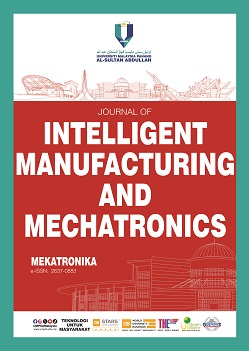Improved Inverted Pendulum Control through PID and EPID Controllers
DOI:
https://doi.org/10.15282/mekatronika.v5i2.9785Keywords:
Inverted Pendulum, Control, PID, EPID, Disturbance rejectionAbstract
This presentation is on studies of application of combined constant rate reaching law and proportional-integral-derivative (PID) control law (EPID) for the control of inverted pendulum system. The inverted pendulum system is similar to a typical attitude control of booster rocket undergoing the takeoff process. Recent studies indicated records of higher rates of accidents in aircrafts. The records show that about half results due to malfunctions of aircraft systems and close to one-third from propulsion system malfunctions. Others are higher complexities of modern aircraft systems and in trying to reduce cost of maintenance. Therefore, the need enhanced automation, fault detection, faults isolation, faults tolerance, faults diagnosis and faults correction. Linear control techniques may not yield the desired performances in aircraft systems due to high levels of system nonlinearities. Applications of the intelligent control counterparts may not guarantee the generation of mathematical model for in-depth analysis. The major demerit of nonlinear control methods is higher requirement of computational burden making practical implementation difficult. The model of the inverted pendulum system is a linearized analytical model. The system performance of the system was observed with the EPID and PID controllers. Furthermore the effect of sudden changes such as wind, gust or other related variations on the system was also studied using step disturbance. It was a simulation studies using MATLAB/SIMULINK software. Results showed that with the EPID a near zero deviation was achieved. Whereas with PID controller was able to only maintain a deviation of about 40. Results also indicated a near zero disturbance rejection ability with the EPID, while the PID was able to only suppress the disturbance to some extent. It implies a more robust control with the EPID was achieved for aircraft/inverted pendulum control. Hence, it implies enhanced performance and with further improvement it can be used for application in this class of systems as well as similar systems. The work would help to for basic researches in aircraft/inverted pendulum control for beginners as well as experienced researchers in the field.
Downloads
Published
Issue
Section
License
Copyright (c) 2023 Universiti Malaysia Pahang Publishing

This work is licensed under a Creative Commons Attribution-NonCommercial 4.0 International License.




